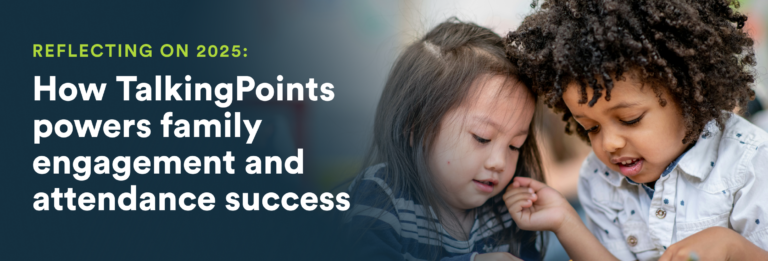Written by Paige DeLozier
Families can be one of the greatest untapped assets schools have to support students and send student success soaring—if only everyone knew this secret and how to leverage the power of engagement!
Fortunately, we’re at a point in time when family engagement is gaining the recognition it deserves. In a major address delivered in January, US Secretary of Education Miguel Cardona outlined a series of priorities. The very first one he mentioned? “Engaging families as core partners to educators.”
Why does family engagement really matter?
Family engagement has proven to be twice as effective in predicting a student’s outcome than their family’s socioeconomic status. Afterall, family members shape the environment at home and are a child’s first teachers. This makes them a teacher’s greatest ally in creating the ideal educational experience for their child.
So, if families are so important to a child’s educational journey, where do we begin to build the connections necessary to foster that kind of engagement? Here are some things to keep in mind when beginning to set your personal family engagement goals.
1 – Great minds think alike
When you begin looking for ways to boost and improve your own family engagement, consider what you and your students’ families all want the outcome to be. Everyone wants the same thing—student success.
Knowing that everyone is working towards the same goal, you can then learn what each family views as success for their individual child. Ask questions. Give them a voice. You will encounter parents and families who have never actually been asked what they want for their child, and you might be surprised at what you learn.
Use these helpful intake questions to get to know families instantly!
Assuming good intentions and expecting a reasonable level of involvement, start to plan, step-by-step, what your engagement with each family should look like throughout the year.

TP Tip #1: Finding common ground on communication methods and timing is key to keeping the conversation going all year and checking in on goals. Find your main point(s) of contact and make sure their information is up-to-date in TalkingPoints so they never miss a message or announcement.
2 – Build trust from the beginning
The most engaged families are those who feel safe and welcome within the school community and the school building and, in order to feel safe and welcome, they have to trust the people and systems within.
One of the greatest barriers to family engagement that exists right now are the preconceptions family members have about schools and teachers based on their own lived experiences. It can be especially difficult to overcome a family’s past negative experiences and build trust. In the first few days and weeks, some very real and careful work needs to be done by way of relationship building.
Relationships with families will be strongest if they are built and fostered from the very beginning. Some teachers even start over the summer—if they have access to contact information—sending messages or doing home visits!

TP Tip #2: Using attached videos with translated captions, send a quick tour of your classroom to students right before the first day of school so families and students can know what to expect. This can be a great way to ease everyone into the new school year by getting them involved.
TP Tip #3: Save message templates you notice are working for you! If you seem to get a good number of responses from a certain type of message or you use it a lot, save it so you won’t have to keep remaking it. Work smarter, not harder!
3 – Meet families where they are
Teachers know that best practice is to meet students where they are and measure progress from there. Why not do the same with families?
After getting a solid understanding of each family’s wants and needs for their children, and gathering all the personal contact information you’re going to need throughout the year, you’re ready to begin your family engagement plan!
Connecting with all families means using the most accessible means of technology available and making the information you send timely, relevant, and understandable. This is where TalkingPoints can truly be an asset in reaching everyone equitably.
Research has shown that families living in under-resourced, multilingual communities are much more likely to have a cell phone than access to reliable wifi and a computer with email. And phone calls can be intimidating if English is not the recipient’s home language.
Texting is a quick and simple way to get in touch with most families using a tool they’ve already got. Add in automatic translation into each contact’s home language and you’ve got easy, effective, and equitable family engagement at your fingertips!

TP Tip #4: When you’re composing an announcement on the web, the TalkingPoints Readability Flag will pop up if the message is above a 5th grade reading level. This is to help you write the best messages for all families regardless of language or literacy level!
4 – Ensure family members feel valued
One thing that is often forgotten about a parent or guardian’s role in the classroom is that they are major stakeholders in their child’s education from start to finish. We often view them as onlookers or as those watching the process when they are, in fact, central to the process.
There are various ways to help family members begin to feel like part of the school or classroom community. We’ve put together some examples here.
- Extend a personal welcome and check in periodically
- Make sure families see themselves represented in the school culture
- Set goals with families around student and school success
- Offer opportunities for all family members to get involved
TP Tip #5: Utilize both class-wide announcements and direct messages to communicate with and get to know family members so you can understand their needs best. In turn, they can better understand you as their child’s teacher!
Family engagement, when done with commitment and intention, is a partnership with families in pursuit of a common goal for the children. Taking steps like the ones above, though seemingly small, build a foundation of trust that make way for long term relationships in a learning community. That’s what engagement and involvement is all about.



